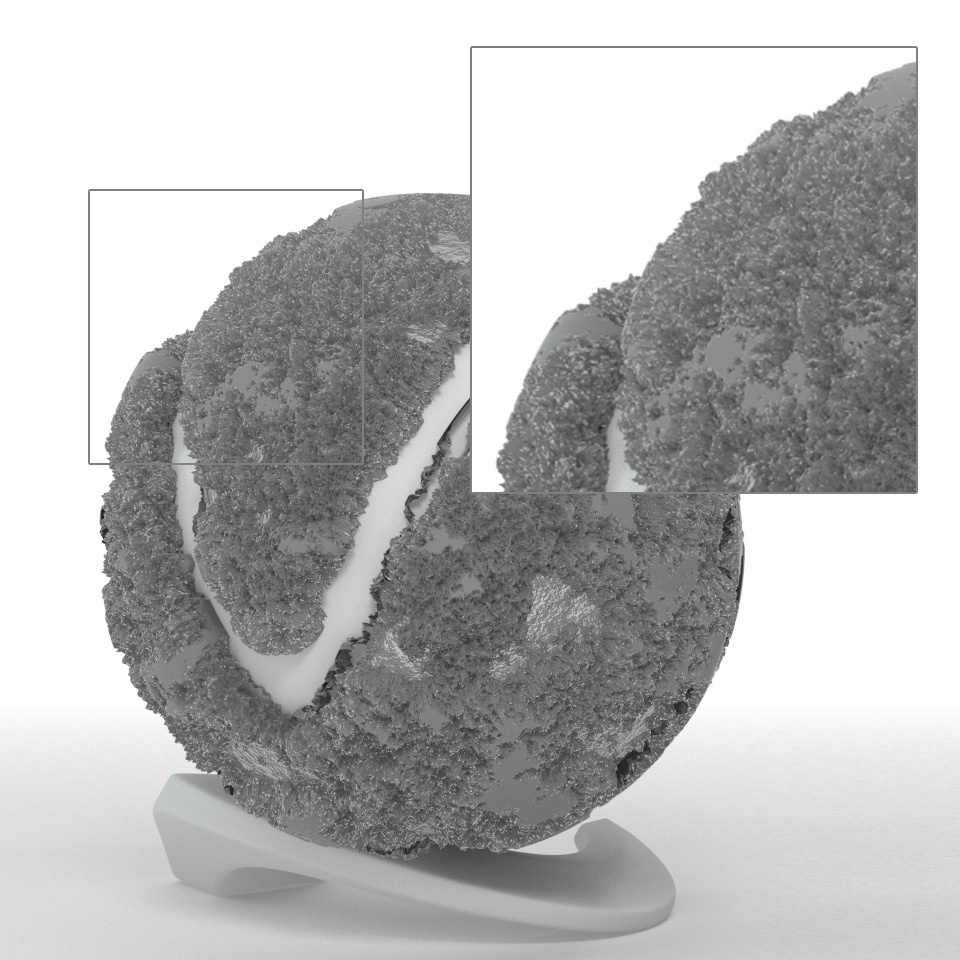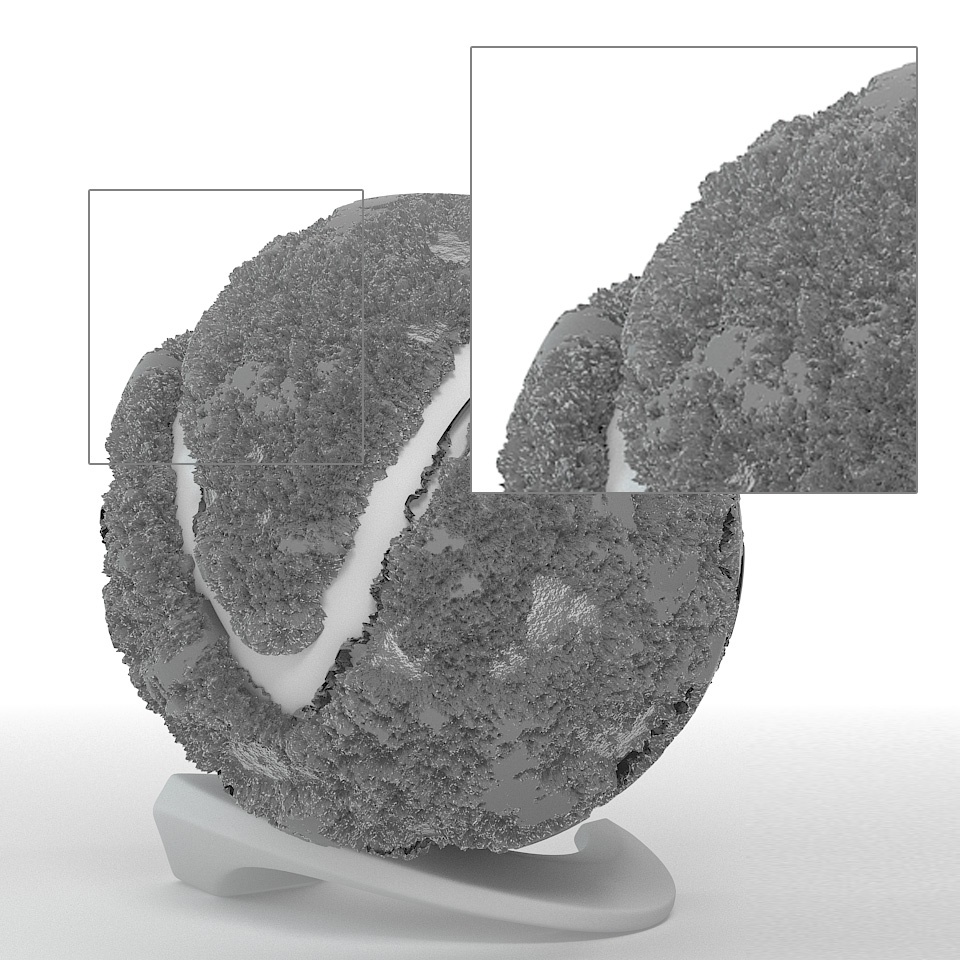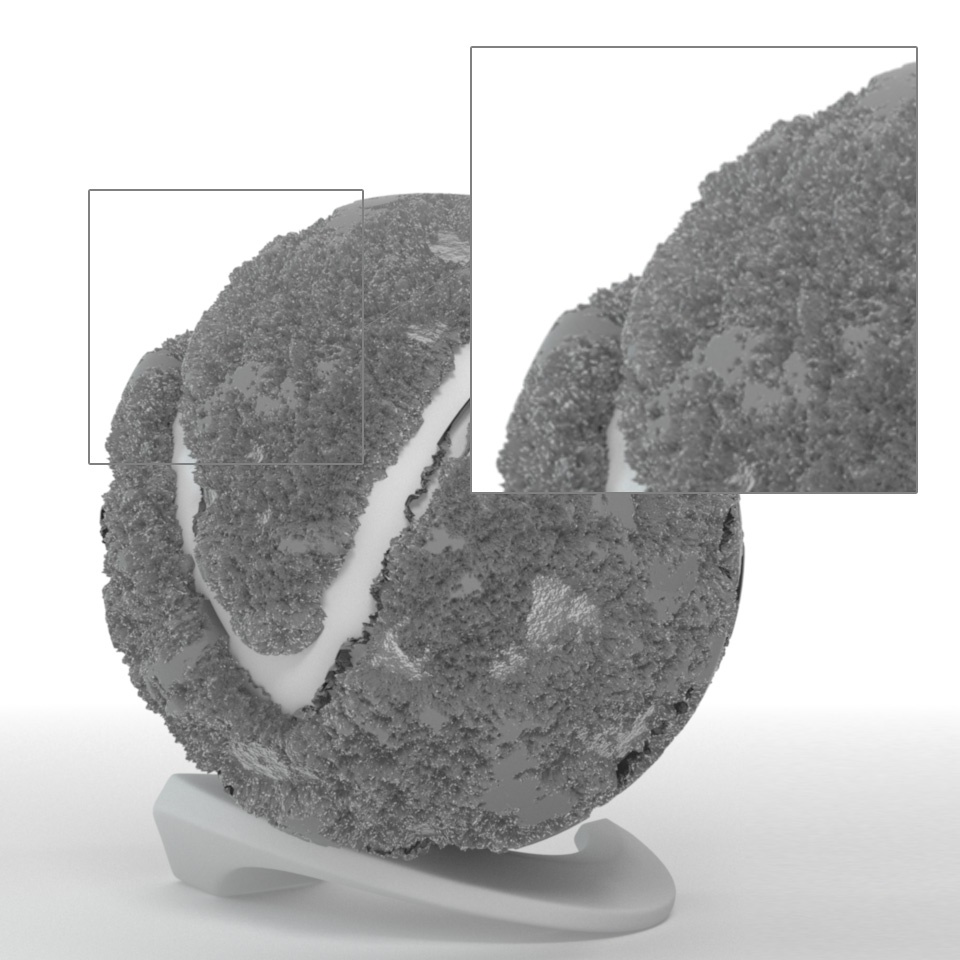Page History
This page provides information on the Anti-Aliasing options in the Sampler tab of the V-Ray Renderer.
Page Contents
| Table of Contents | ||||
|---|---|---|---|---|
|
Overview
...
| Section | |||||||||||||||||
|---|---|---|---|---|---|---|---|---|---|---|---|---|---|---|---|---|---|
|
UI Path: ||Parameters tab|| > Sampler tab
(with the V-Ray Renderer node selected)
...
...
What is Anti-Aliasing?
One of the functions of image sampling is One of the functions of image sampling is anti-aliasing, which is the reduction of jagged edges in a rendering. The following example shows the basic difference between an image with anti-aliasing, and one without. The left images are jagged around the edges
If only one sample is taken for each of the pixels around the edge of the sphere, while the right are smooth.Here we have an example of a gray sphere against a blue background. If only one sample is taken for the each of the pixels around the edge of the sphere, the choice of pixel color is limited to the dark gray at the edge of the sphereobject, or the blue (white) background. Using one of these colors (iei.e. taking only one sample) makes the image look jagged around the perimeter of the sphere. This is the equivalent of no anti-aliasing at all.
If two or more samples are taken in each pixel, the colors are averaged, and pixels at the edge of the sphere object end up being a color in between the dark gray of the sphere and the blue background. These in-between colors make the sphere object appear smoother in the final rendering.
| Section | ||||||||||||||||||||||||||||
|---|---|---|---|---|---|---|---|---|---|---|---|---|---|---|---|---|---|---|---|---|---|---|---|---|---|---|---|---|
| ||||||||||||||||||||||||||||
|
Anti-Aliasing
...
| Section | ||||||||||
|---|---|---|---|---|---|---|---|---|---|---|
|
Anti-Aliasing
...
|
...
|
...
|
...
...
|
...
|
...
|
...
|
...
|
...
|
...
|
...
|
...
|
...
|
...
|
...
|
...
|
...
|
...
|
...
For more information, see the Render Mask example below.
Object IDs – Specifies a list of object IDs to be used for the render mask.
Filter Type – Specifies the filter type to be used for anti-aliasing. V-Ray supplies eight types of Anti-aliasing filters: Box, Area, Triangle, Lanczos, Sinc, CatmullRom, Gaussian and Cook Variable. Each has advantages and disadvantages, which make them useful for different tasks. For more information, see the Anti-aliasing Filters example and the Anti-aliasing Filters and Moire Effects example below.
Filter Size – Determines the size of the filter in pixels. Higher values yield blurrier results. For more information, see the Anti-aliasing Filters example and the Anti-aliasing Filters and Moire Effects example below.
...
Example: Anti-aliasing Filters
Here is an example briefly demonstrating the effect of different anti-aliasing filters on the final result.
Note that rendering with a particular filter is not the same as rendering without a filter and then blurring the image in a post-processing program like Adobe Photoshop. Filters are applied on a sub-pixel level, over the individual sub-pixel samples. Therefore, applying the filter at render time produces a much more accurate and subtle result than applying it as a post effect. The zoomed in images below have been zoomed in and cropped 300%.
...
Filter
...
Filtering is off.
...
...
...
...
...
...
...
...
...
...
...
...
...
...
...
...
...
Gaussian
size 2.5
...
...
...
Gaussian blur.
...
Example: Anti-aliasing Filters and Moire Effects
This example demonstrates the effect anti-aliasing filters have on moire effects in your images. Sharpening filters may enhance moire effects, even if your image sampling rate is very high. Blurring filters reduce moire effects.
Note that moire effects are not necessarily a result of poor image sampling. In general, moire effects appear simply because the image is discretized into square pixels. As such, they are inherent to digital images. The effect can be reduced through the usage of different anti-aliasing filters, but is not completely avoidable.
The scene is very simple: a sphere with a very fine checker map applied. The images were rendered with a very high sampling rate (15 subdivs, or 225 rays/pixel). This is enough to produce quite an accurate approximation to the pixel values. Note that the image looks quite different depending on the filter:
| Section | ||||||
|---|---|---|---|---|---|---|
|
| Section | ||||||
|---|---|---|---|---|---|---|
|
| Section | ||||||
|---|---|---|---|---|---|---|
|
...
Example: Render Mask
| Section | ||||||||||||||||||||
|---|---|---|---|---|---|---|---|---|---|---|---|---|---|---|---|---|---|---|---|---|
|
| Section | |||||||||||||||
|---|---|---|---|---|---|---|---|---|---|---|---|---|---|---|---|
|
...
Progressive Sampler
This section provides information specific to the Progressive Sampler Type. The Progressive sampler renders the entire image progressively in passes.
The advantage of this sampler is that you can see an image very quickly, and then let it refine for as long as necessary as additional passes are being computed. This is contrast to the bucket-based image samplers, where the image is not complete until the final bucket is done.
A disadvantage is that more data needs to be kept in memory, especially when working with render elements. Also, when using distributed rendering, because of the continuous refinement, frequent communication between the client machine and the render servers is required, which may reduce the CPU utilization on the render slaves. This effect can be controlled to some extent using the Ray bundle size parameter.
Min Subdivs – Controls the minimum number of samples that each pixel in the image will receive. The actual number of the samples is the square of the subdivs. Note: Not available when using a GPU-based Production engine.
Max Subdivs – Controls the maximum number of samples that each pixel in the image will receive. The actual number of the samples is the square of the subdivs. If zero, the number of samples is not limited.
Noise Threshold – The desired noise level in the image. If this is 0.0, the entire image is sampled uniformly until either the Max. subdivs value is reached or the Render time limit is reached.
Max. Render Time (min) – The maximum render time in minutes. This is the render time for the final pixels only; it does not include any GI prepasses like light cache, irradiance map etc. If this is 0.0, the render is not limited in time.
Ray Bundle Size – Useful for distributed rendering to control the size of the chunk of work that is handed to each machine. When using distributed rendering, higher values may help to utilize CPUs on the render servers better.
| UI Text Box | ||
|---|---|---|
| ||
Avoid using the Progressive sampler with sharpening image filters (Catmull-Rom, Mitchell-Netravali) as this may slow down the rendering - additional image samples will be required to resolve sharpening filters properly. V-Ray will print a warning in this case in the V-Ray messages window. |
Example: Stages of Rendering with the Progressive Sampler
| Section | ||||||||||||||||||||
|---|---|---|---|---|---|---|---|---|---|---|---|---|---|---|---|---|---|---|---|---|
|
| Section | ||||||||||||||||||||
|---|---|---|---|---|---|---|---|---|---|---|---|---|---|---|---|---|---|---|---|---|
|
...
Adaptive Sampler
This section covers information specific to the Bucket Sampler Type.
This sampler makes a variable number of samples per pixel based on the difference in intensity between the pixel and its neighbors.
This is the preferred sampler for images with lots of small details (like Procedural Fur for example) and/or blurry effects (DOF, motion blur, glossy reflections etc).
The diagram above shows visually the way V-Ray is placing samples when using the Bucket sampler. The black squares represent the pixels of the image while the dots represent the individual samples. In the first pass V-Ray always places the minimum number of samples determined by the Min. subdivs parameter. Then the color of the samples is compared and more are added where needed in the following passes.
Note: Not available when using a GPU-based Production engine.
Lock Subdivs – Sets a fixed number of samples taken for each pixel.
...
|
Anchor antialiasingFilters antialiasingFilters
...
Example: Anti-aliasing Filters
Here is an example briefly demonstrating the effect of different anti-aliasing filters on the final result.
Note that rendering with a particular filter is not the same as rendering without a filter and then blurring the image in a post-processing program like Adobe Photoshop. Filters are applied on a sub-pixel level, over the individual sub-pixel samples. Therefore, applying the filter at render time produces a much more accurate and subtle result than applying it as a post effect. The zoomed in images below have been zoomed in and cropped 300%.
| Section | ||||||||||||||||||||||||||||||||||||||||||||||||||||||||||||||
|---|---|---|---|---|---|---|---|---|---|---|---|---|---|---|---|---|---|---|---|---|---|---|---|---|---|---|---|---|---|---|---|---|---|---|---|---|---|---|---|---|---|---|---|---|---|---|---|---|---|---|---|---|---|---|---|---|---|---|---|---|---|---|
|
| Anchor | ||||
|---|---|---|---|---|
|
...
Example: Anti-aliasing Filters and Moire Effects
This example demonstrates the effect anti-aliasing filters have on moire effects in your images. Sharpening filters may enhance moire effects, even if your image sampling rate is very high. Blurring filters reduce moire effects.
Note that moire effects are not necessarily a result of poor image sampling. In general, moire effects appear simply because the image is discretized into square pixels. As such, they are inherent to digital images. The effect can be reduced through the usage of different anti-aliasing filters, but is not completely avoidable.
The scene is very simple: a sphere with a very fine checker map applied. The images were rendered with a very high sampling rate (15 subdivs, or 225 rays/pixel). This is enough to produce quite an accurate approximation to the pixel values. Note that the image looks quite different depending on the filter:
| Section | ||||||||||||||||||||||||||||||||||||||||||||||||||||||||||||||
|---|---|---|---|---|---|---|---|---|---|---|---|---|---|---|---|---|---|---|---|---|---|---|---|---|---|---|---|---|---|---|---|---|---|---|---|---|---|---|---|---|---|---|---|---|---|---|---|---|---|---|---|---|---|---|---|---|---|---|---|---|---|---|
|
| Anchor | ||||
|---|---|---|---|---|
|
...
Example: Render Mask
| Section | |||||||||||||||||||||||||
|---|---|---|---|---|---|---|---|---|---|---|---|---|---|---|---|---|---|---|---|---|---|---|---|---|---|
|
| Section | |||||||||||||||||||||||||
|---|---|---|---|---|---|---|---|---|---|---|---|---|---|---|---|---|---|---|---|---|---|---|---|---|---|
|
| Anchor | ||||
|---|---|---|---|---|
|
Progressive Sampler
...
| Section | ||||||||||||||||||||
|---|---|---|---|---|---|---|---|---|---|---|---|---|---|---|---|---|---|---|---|---|
|
...
Example: Stages of Rendering with the Progressive Sampler
| Section | ||||||||||||||||||||||||||||||||||||||||||
|---|---|---|---|---|---|---|---|---|---|---|---|---|---|---|---|---|---|---|---|---|---|---|---|---|---|---|---|---|---|---|---|---|---|---|---|---|---|---|---|---|---|---|
|
| Anchor | ||||
|---|---|---|---|---|
|
| Anchor | ||||
|---|---|---|---|---|
|
Bucket Sampler
...
| Section | |||||||||||||||
|---|---|---|---|---|---|---|---|---|---|---|---|---|---|---|---|
|
| Section | |||||||||||||||
|---|---|---|---|---|---|---|---|---|---|---|---|---|---|---|---|
|
Textures
...
| Section | |||||||||||||||||||||||||
|---|---|---|---|---|---|---|---|---|---|---|---|---|---|---|---|---|---|---|---|---|---|---|---|---|---|
|
Post Effects
...
| Section | |||||||||||||||
|---|---|---|---|---|---|---|---|---|---|---|---|---|---|---|---|
|
Max Subdivs – Determines the maximum number of samples for a pixel. The actual maximum number of samples is the square of this number (e.g. 4 subdivs produces a maximum of 16 samples). Note that V-Ray may take less than the maximum number of samples, if the difference in intensity of the neighboring pixels is small enough.
Threshold – The threshold that will be used to determine if a pixel needs more samples. For more information, see The Threshold Parameter example below.
...
Example: The Threshold Parameter
...
This example deals with texture anti-aliasing and the effect of the color threshold for the Bucket sampler.
By default V-Ray anti-aliases everything in the image, including textures. This is especially useful for textures with small details or noisy bump maps. The Threshold parameter controls the extent to which texture anti-aliasing is performed. The effect of this parameter is most noticeable with low min rates. For the four images below, min/max rate of -3/2 was used:
| Section | ||||||||||||||||||||
|---|---|---|---|---|---|---|---|---|---|---|---|---|---|---|---|---|---|---|---|---|
|
| Section | ||||||||||||||||||||
|---|---|---|---|---|---|---|---|---|---|---|---|---|---|---|---|---|---|---|---|---|
|
Note that the edges of the object in those images are always sharp.
If you set the Threshold to a high value, you are effectively telling V-Ray not to anti-alias textures. You can use this fact to speed up the rendering of complex materials. Note however, that this will disable anti-aliasing of V-Ray shadows, reflections etc as well.
...
| Anchor | ||||
|---|---|---|---|---|
|
Notes
...
| Fancy Bullets | ||
|---|---|---|
| ||
|

































